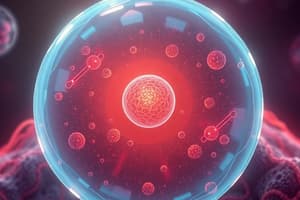Podcast
Questions and Answers
How does the plasma membrane help maintain homeostasis in a cell?
How does the plasma membrane help maintain homeostasis in a cell?
The plasma membrane filters what substances go in and out of the cell, disposes of excess substances, and allows needed substances in through selective permeability.
How does the inside of a cell remain separate from its environment?
How does the inside of a cell remain separate from its environment?
With the phospholipid bilayer.
What are the major components of a plasma membrane?
What are the major components of a plasma membrane?
Phospholipid bilayer, cholesterol, proteins, and carbohydrates.
Which membrane component provides basic membrane structure?
Which membrane component provides basic membrane structure?
Which membrane component provides cell identity?
Which membrane component provides cell identity?
Which membrane component enables the membrane to have fluidity?
Which membrane component enables the membrane to have fluidity?
Which membrane component enables a cell to transport materials across the membrane?
Which membrane component enables a cell to transport materials across the membrane?
Why is selective permeability important in a plasma membrane?
Why is selective permeability important in a plasma membrane?
Why is it important for a cell to maintain homeostasis?
Why is it important for a cell to maintain homeostasis?
Which organelle is primarily responsible for maintaining homeostasis in a cell?
Which organelle is primarily responsible for maintaining homeostasis in a cell?
Explain what a mosaic is.
Explain what a mosaic is.
How does the orientation of the phospholipids in the bilayer allow a cell to interact with its internal and external environment?
How does the orientation of the phospholipids in the bilayer allow a cell to interact with its internal and external environment?
What happens during equilibrium?
What happens during equilibrium?
What would happen to a cell placed in a strong salt solution?
What would happen to a cell placed in a strong salt solution?
What would happen to a cell placed in pure water?
What would happen to a cell placed in pure water?
How are cells able to get dissolved materials inside?
How are cells able to get dissolved materials inside?
What are 3 examples of passive transport?
What are 3 examples of passive transport?
Are osmosis and diffusion examples of active or passive transport?
Are osmosis and diffusion examples of active or passive transport?
What are 3 examples of active transport?
What are 3 examples of active transport?
What does a transport protein do?
What does a transport protein do?
How would a large particle enter a cell?
How would a large particle enter a cell?
How is facilitated diffusion different from active transport?
How is facilitated diffusion different from active transport?
Summarize how cellular transport helps maintain homeostasis within a cell.
Summarize how cellular transport helps maintain homeostasis within a cell.
Flashcards are hidden until you start studying
Study Notes
Plasma Membrane and Homeostasis
- The plasma membrane regulates what enters and exits a cell, helping maintain internal balance.
- Selective permeability allows the membrane to remove excess substances and intake necessary ones.
- This process is crucial for eliminating waste and sustaining metabolic needs.
Cell Structure and Components
- The plasma membrane consists mainly of a phospholipid bilayer, cholesterol, proteins, and carbohydrates.
- Phospholipid bilayer provides the foundational structure of the membrane.
- Carbohydrates function in cell identity, acting as markers for recognition.
- Cholesterol contributes to the fluidity of the membrane, enhancing flexibility.
Mechanisms of Transport
- Proteins within the membrane facilitate the transport of materials across it.
- Selective permeability prevents harmful substances from entering the cell, crucial for cell survival.
- To ensure proper function, cells must maintain homeostasis, which involves constant regulatory actions from the plasma membrane.
Understanding Membrane Dynamics
- The term "mosaic" describes the diverse components of the membrane that float and move in a fluid manner.
- Orientation of phospholipids is critical; hydrophilic heads face outward, and hydrophobic tails face inward, maintaining a protective barrier.
Passive vs. Active Transport
- Passive transport does not require energy and includes diffusion, osmosis, and facilitated diffusion.
- Active transport, however, requires energy (ATP) and includes processes like endocytosis, exocytosis, and transport proteins.
- Facilitated diffusion simplifies the movement for larger or charged molecules across the membrane without energy.
Osmosis and Concentration Dynamics
- Equilibrium occurs when particle movements remain random, with no net change in concentration.
- A cell placed in a strong salt solution will shrivel due to water loss, while in pure water, the cell may burst from excess intake.
- Hypotonic solutions lead to water influx; cells adjust concentrations to maintain balance.
Transport Mechanisms
- Cells utilize facilitated diffusion to transport dissolved materials efficiently.
- Endocytosis allows large particles to enter cells, while exocytosis helps expel materials.
- Transport proteins are essential in moving molecules actively across membranes using energy.
Impacts of Environment on Cells
- Organisms in hypertonic environments, like the Great Salt Lake, might develop adaptations to survive osmotic pressure.
- Knowledge of cellular transport mechanisms is fundamental for understanding how cells interact with their surroundings and maintain homeostasis.
Studying That Suits You
Use AI to generate personalized quizzes and flashcards to suit your learning preferences.




